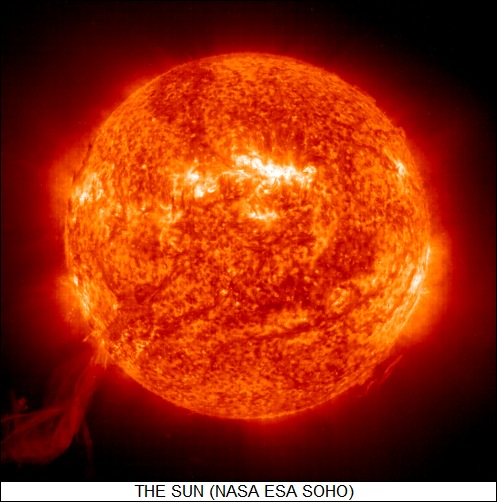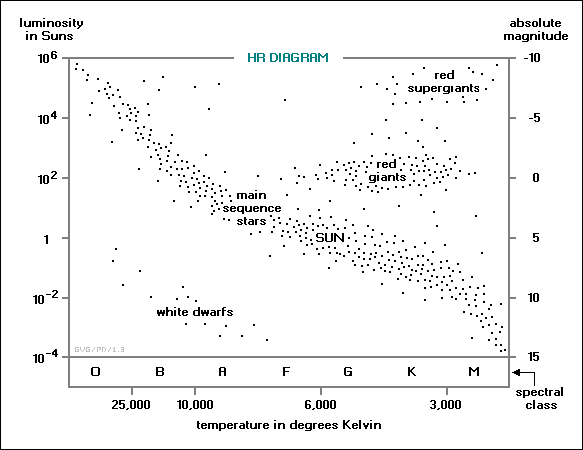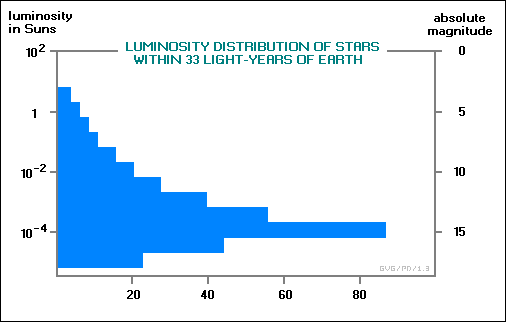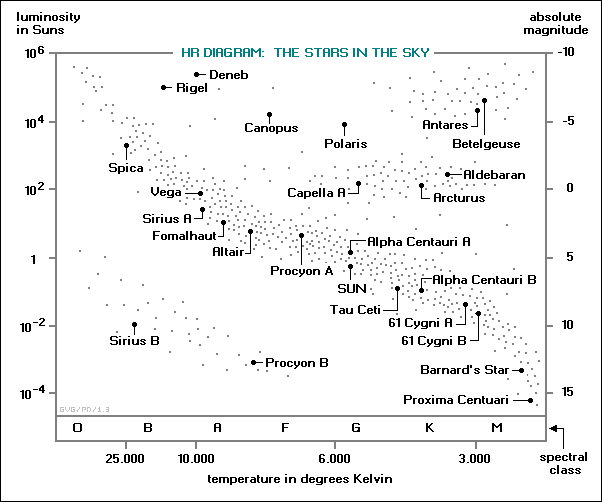
* The stars come in a wide range of sizes and colors, and exhibit an equally wide range of system configurations and behaviors. This chapter discusses the classification of stars.

* Astronomers are able to categorize and describe stars on the basis of a number of properties.
The most basic property is their simple location in the sky. The coordinates of objects are given in terms of celestial analogs of latitude and longitude known as "declination" and "right ascension" respectively. This coordinate system is organized around "celestial poles" defined by a line extending through space and in the direction of the Earth's axis of rotation, and a "celestial equator" defined by a plane running through the Earth's equator. Declination and right ascension are given in degrees, with declination ranging from 0 degrees at the celestial equator up to 90 degrees at the celestial poles. Right ascension ranges from 0 to 360 degrees, increasing to the east, with the zero coordinate in the direction of the constellation Pisces.
The Earth's direction of spin is not fixed. The Earth's spin has a "wobble" or "precession" that causes the poles to move around a circle in the sky once every 26,000 years. This means that the coordinates of stellar objects in terms of declination and right ascension vary over time, and properly declination and right ascension have to be given along with a date.
The brightest stars, such as Sirius, Procyon, Rigel, and Betelgeuse, have names of their own, but most stars are given names relative to the constellations they are found in. Astronomers have formally organized the sky into 88 constellations, with well-defined boundaries between the constellations. However, since the stars are moving through the sky, the constellations are not permanent features over the long run, and will be distorted or unrecognizable in tens of thousands of years.
Stars within constellations are designated with Greek letters in order of brightness. The brightest star in the Southern Cross, or Crux in Latin, is "Alpha Crucis", the second brightest in "Beta Crucis", and so on. A star may have both a formal name and constellation designation. For example, Sirius is "Alpha Canis Majoris". Once the Greek alphabet is used up, pairs of Roman characters are used instead.
Other stars discovered in more recent times are often just named after their discoverer, such as Barnard's Star, or have catalog entries and are usually designated with the initials of the catalog and their celestial coordinates. There are a large number of such celestial catalogs, with the most famous being Messier's list of nebulas, and the "New General Catalog (NGC)", which despite its name dates from the late 19th century.
* Other properties of a star include its rate of angular motion, or proper motion, across the sky; its velocity along a line of sight to the Earth, or radial motion, as determined by the Doppler shift of its spectrum; its color, which implies its temperature; and its luminosity, or brightness.
Astronomers, following a scheme invented by Hipparchus, measure the luminosity of a star or other cosmic object using a logarithmic scale, with increasing values counter-intuitively indicating a dimmer object, and each integer value on the scale being 2.512 times dimmer than the one before. That is, a star of magnitude 2 is 2.512 times dimmer than one of magnitude 1, a star of magnitude 3 is 2.512 times dimmer than one of magnitude 2, and so on. The magic value of 2.512 was selected because five such steps give a multiple of 100 (2.512^5 = 100), and so a star of magnitude 1 is 100 times brighter than one of magnitude 6. In base-10 logarithms, one order of magnitude corresponds to a log value of 0.4, since 100 = 10^2 and 2/5 = 0.4. Magnitudes can go into negative values for very bright objects. For example, the Moon has a magnitude of -12.5, and the Sun has a magnitude of -26.8.
Astronomers speak of the perceived brightness, or "visual magnitude", of a star as it is seen in the night sky in comparison to other stars, and its "absolute magnitude", which is how bright it would be if it were ten "parsecs" away. A parsec, or "parallax-second", is the distance of a star that gives it a parallax shift of one second of arc as seen from the Earth over a period of six months. A parsec is equivalent to 3.262 light years, and so the absolute magnitude of a star is the brightness it would have at a distance of 32.62 light years.
* There are subtler properties as well. There is a "bolometric magnitude", which is a measure of a star's emission through the entire electromagnetic spectrum, including not only the visual wavelengths but also the infrared and ultraviolet wavelengths. This is tricky to measure, and there is also the issue that the brightness perceived at different wavelengths is not necessarily the same for the eye as it is for photographic film or an electronic sensor. For this reason, brightness measurements are generally taken using standard sets of filters and then calculated according to standard formulas.
Spectroscopy is used to obtain most of the other information about stars. Along with stellar composition, radial velocity, and rotation rate, spectroscopy can be used to determine the size of orbits in binary systems, which allows a determination of stellar mass. Strong magnetic fields cause a "splitting" of spectral lines, and this "Zeeman effect" can be used to estimate the strength of stellar magnetic fields.
BACK_TO_TOP* The classification system devised by Pickering is still in use in the 21st century. Ordinary stars are classified as follows:
Three classes, "R", "N", and "S", were assigned for unusual dying red stars rich in carbon, with class R and N later combined into class "C" (for "carbon stars"). A class "W" was defined for "Wolf-Rayet stars", which are apparently dying supergiants that have lost their hydrogen atmospheres. These types are not really normal members of the stellar population, and these classifications are often ignored in discussions of stellar spectra.
White dwarfs are classified as "DA", "DB", "DC", "DO", "DQ", "DX", and "DZ" -- or sometimes simply referred to as "WD" stars. The discovery of substellar brown dwarf stars has led to three more classes -- "L", "T", and "Y" -- to categorize small red dwarf stars and brown dwarfs as a continuum.
The seemingly haphazard ordering of the main-sequence stellar classes as "OBAFGKM" is an historical artifact. One of Pickering's assistants, Wilhelmina Fleming, gave the stellar classes a nice neat alphabetical sequence early in the group's stellar classification effort, but by the end of the work, they had been forced to drop some classes and shuffle others around.
While the list above defines the stellar classes by color and mass, as the story of their origin implies, they were originally defined by spectral features. Hydrogen lines grow stronger in the spectra of classes O through A, and then become steadily weaker until they disappear in class M. The spectra of class O stars display absorption lines of ionized helium, while the spectra of B stars display absorption lines of neutral helium.
Astronomers somewhat confusingly refer to all elements heavier than helium as "metals". In this document, that particular interpretation of the word will always be given in quotes. In any case, the spectral lines of "metals" vary in a smooth way through the spectra of class A through class M stars. Ionized calcium lines grow in strength in the class A through G, but weaken for the later classes while lines of neutral calcium and sodium grow in strength. The spectra of M-class stars feature molecular lines, particularly those of titanium oxide (TiO).
* Astronomers also divide each class into ten subclasses, with 0 being the coolest subclass and 9 being the hottest subclass. Our own Sun is classified as a G2 star. There are also auxiliary subclassifications for anomalous stars in a class -- they were once simply labeled "peculiar", but that seemed inadequate; the spectra of such stars resembles that of a well-defined stellar class but exhibits unique features.
Spectral classifications can be used to an extent to provide a rough estimate of the brightness and so the distance of a star. This technique is sometimes referred to by the somewhat misleading name of "spectroscopic parallax", although in itself it involves no trigonometric measurements.
* The HR diagram, enhanced to reflect stellar classes and the absolute magnitude scale, looks like this:

Neutron stars and black holes do not show up on the HR diagram, since a neutron star is very faint at best in the visible wavelengths, and a black hole as such is invisible. The brown dwarf substars, which are too small to initiate sustained fusion reactions, also do not show up on the HR diagram.
The main sequence classes are based on color and temperature and say nothing about a star's actual size or luminosity. A class M star could be a dim dwarf or a bright giant. For this reason, an auxiliary "luminosity" classification was defined as well in the ATLAS OF STELLAR SPECTRA, published by William Morgan, Paul Keenan, and Edith Kellman in 1943. The "MKK" luminosity classifications include:
These luminosity classifications are based on luminosity curves, not simple ranges of luminosity values. Luminosity class Ia supergiants are of similar magnitude no matter what their spectral classification is, while the luminosity range of luminosity class V main sequence stars tracks the main sequence curve on the HR diagram. Using this scheme, a red dwarf might be a M0-V star, while a red giant might be an M0-II star,
* Binaries are extremely common and more complicated multiple star systems, such as triple, quadruple, or even sextuple systems are known. Multiple star systems are usually "hierarchical". For example, a triple-star system normally consists of two stars in a close orbit and a third star in a wide orbit around the other two. The star system of Castor has six stars, in three pairs, with two pairs in orbit with each other, with an orbital period of about 445 years, and the other pair in orbit around the other four stars, with an orbital period of about 14,000 years. The orbital periods of each of the three pairs are on the order of days.
The alternative, known as a "Trapezium" system after an example in the Orion Nebula, involves multiple stars orbiting with roughly equal separations. Trapezium systems only occur in young star systems, since they are unstable. Sooner or later, some event will scatter the stars in the system. Hierarchical systems are stable and persist.
When binary stars are very close together, they can distort their shapes into ellipses, as in the case of the close binary Beta Lyrae. Some are so close together that they share a common stellar envelope, as is the case for the binary W Ursae Majoris. In some cases, the interactions between the two stars can distort the evolution of the stars, or lead to violent, explosive, or even cataclysmic interactions, which are discussed later.
* Variable stars are also common, and cover a wide range of types. The T Tauri stars, for example, are young, bright giant stars that are unstable and vary in brightness in an unpredictable fashion. Eclipsing variables, as mentioned earlier, are binary stars in which one of the stars eclipses the other on a regular basis. There are also "rotating variables", which are stars that are dimmer on one side than the other due to huge "starspots", with their brightness changing as they rotate.
The pulsating variable stars -- also mentioned earlier, as "standard candles" for estimating cosmic distances, come in a somewhat confusing range of types:
* There is also a variety of "eruptive variables". While our Sun emits occasional flares that can cause disruption of radio communications and even power grids, there is a class of "flare stars" that will increase in brightness by about a factor of 40 in a few seconds, and then fade in a few minutes. Flare stars tend to be relatively young, small, cool main sequence stars that are clearly going through an unstable phase.
In late 2005, a flare star designated II Pegasi A featured an eruption that was about a hundred million times more powerful than any flare emitted by our own Sun. If such a flare had occurred on our Sun, it would have caused an extinction event on Earth. II Pegasi A has a mass of about 0.8 solar masses and is otherwise not typical of flare stars, but it is in close orbit with a companion, II Pegasi B, which has a mass of about 0.4 solar masses. They are locked in a mutual orbit that only takes a week and are tidally "locked" so they have the same rotation rate. The high spin rate seems to be associated with flares in young stars and is believed to be the source of flare behavior in II Pegasi A.
The exploding stars astronomers originally called "novas" have turned out to be a variety of different phenomena. The terms "nova" and "dwarf nova" are now applied to explosions that appear on a periodic basis in binary systems featuring large star and a white dwarf. Such binaries can in some cases produce a vastly more violent explosion, known as a "Type I sypernova", involving the complete destruction of the white dwarf. Another type of comparably violent explosion involves the destructive collapse of a very massive star, and this event is known as a "Type II supernova". Novas and supernovas are also discussed in detail later.
One of the oddest types of variable stars is the R Coronae Borealis class. These bizarre stars are sometimes called "reverse novas", because instead of abruptly turning bright, they abruptly go dark, by as much as an order of magnitude, and stay that way for a few years. These are apparently old supergiant stars that are rich in carbon, and through some process they occasionally develop a layer of sooty gas that causes them to go dim for a time. They are also often pulsating variable stars.
BACK_TO_TOP* The Sun is the nearest star, a little less than 150 million kilometers away, and so the one we know best. It is a yellow G2 main sequence star, composed of about three-quarters hydrogen, about a quarter helium, less than a percent oxygen, less than a third of a percent carbon, and about half a percent everything else. Interestingly, the spectra of the Sun is dominated by the absorption lines of sodium and ionized calcium, though the quantities of both are small.
Other interesting statistics include:
The visible surface of the Sun is known as the "photosphere". The photosphere has a granulated appearance, and occasionally features cooler areas that appear relatively dark in photographs, and are called "sunspots".
The Sun has an atmosphere of sorts, which is divided into two layers. The lower layer is known as the "chromosphere", which varies in height but can reach an altitude of up to 30,000 kilometers. Temperature rises with height through the chromosphere, reaching a level of a million degrees Kelvin at the top where it fades into the corona, which in turn fades outward far into space, generating a flow of particles known as the "solar wind" that sweeps past the Earth.
The Sun is a ball of hot gases, not a solid object, and so rotation varies with latitude. Near the poles, the photosphere rotates once every 37 days, while at the equator the period is about 26 days. Since the Sun is made up of electrically conductive plasma, its rotation amounts to a huge electrical current, which produces a magnetic field. The nonuniform rotation of the Sun in turn causes this magnetic field to become very tangled and nonuniform.
Sunspots occur in regions where the magnetic field is very intense. They vary considerably in size, but on the average are about 8,000 kilometers across. Sunspots tend to cluster near the solar equator and they come and go over an average period of about 11 years, though in fact sunspot activity periods have varied from 7 to 17 years. When the number of sunspots reaches a peak, the Sun exhibits other unusual behavior, particularly eruptions known as "solar flares" that occur where the twisted magnetic fields are extraordinarily strong.
Solar flares can emit energy all the way up to the X-ray regions of the spectrum, and they release energetic particles into the solar wind. Solar particles spiraling into the Earth's magnetic field cause ghostly displays of fluorescence in the night skies at northern latitudes. These displays are called "auroras" or the "northern lights". Intense "solar storms" can disrupt communications and electrical power grids on Earth; one that took place in late August 1859 produced auroras that could be seen from the Equator, and lit up the skies so brightly at higher latitudes that people could read newspapers on the streets at night. Telegraph systems were completely disabled. A solar storm of that intensity is estimate to take place about once every 500 years or so -- and if one took place today, it would not only disrupt communications, but also take down power grids and fry satellites.
The Sun has been observed by ground-based observatories and dedicated satellites. One particularly interesting set of observations have been performed by detectors in deep mines searching for "neutrinos", which are ghostly particles released in stellar nuclear reactions that pass through matter largely unimpeded. There is a small probability that they will interact with matter, and many neutrino detectors consist of tanks of liquid where such interactions take place and are detected at extremely low rates.
These detectors have little directional capability and so pick up neutrinos from all directions in space. However, the Sun is the predominant neutrino source, and so most of the neutrinos can be assumed to come from the Sun. Experiments have shown that the Sun's production of neutrinos is smaller than theory suggests. This mystery of the "missing neutrinos" persisted for three decades, but gradually neutrino detectors demonstrated that it was due to the fact that solar neutrinos could change "flavor". There are three types or "flavors" of neutrinos, including "electron", "muon", and "tau" neutrinos. The Sun's nuclear reactions produce electron neutrinos, but as it turns out these can change flavor into muon and tau neutrinos, which are harder to detect.
* Incidentally, although the Sun has been converting mass to energy for billions of years, it hasn't lost that much mass from this process. The energy output of the Sun is about 3.8 x 10^26 watts, which using Einstein mass-energy relationship E = MC^2 gives the conversion of about 4.2 billion kilograms of mass into energy every second. That gives a loss of about 1.3 x 10^17 kilograms per year, so in a billion years it loses 1.3 x 10^26 kilograms of mass.
That sounds like a lot -- and it is, the equivalent of over 20 Earth masses. However, since the Sun has a mass about 323,000 times that of the Earth, this represents a mass loss of about 0.006%. The Sun is also losing mass to the solar wind; comets and other space junk do fall into it as well, but they add much less mass than is lost.
BACK_TO_TOP* The Sun is a large star compared to most of the others in the vicinity. All the star systems within 12 light-years of the Sun are listed below, arranged in order of increasing distance, with direction ignored:
This list covers 19 star systems with a total of 27 stars. Seven of the star systems are binaries or trinaries, demonstrating how common multiple star systems actually are. Only three of the stars are brighter than the Sun. The Sun is estimated to be in the top 4% of all stars in size.
A plot of the relative proportions of stars of different luminosities in our stellar neighborhood emphasizes the fact that the majority of stars are small and faint:

Many astronomers suspect there are many more faint red dwarfs in our stellar neighborhood that have been overlooked. It is also faintly possible that there may be hidden fossil stars such as white dwarfs, neutron stars, and black holes in nearby space, and there are very likely a fair number of brown dwarf substars.

* Most of the dim stars in our stellar neighborhood are difficult to see or invisible to the naked eye. This means that our night sky is heavily skewed toward the brightest stars and celestial objects. The following table gives the twenty brightest stars, with distances ranging up to 1,400 light-years away, arranged in decreasing order of visual magnitude:
visual absolute distance in
star class magnitude magnitude light years
_____________________________________________________________________
Sirius A A1-V -1.46 +1.4 8.8
B WD +8.7 +11.6
Canopus F0-Ib/II -0.72 -3.1 98
Alpha Centauri A G2-V -0.01 +4.4 4.3
B K0-V +1.3 +5.7
Arcturus K2-III -0.06 -0.3 35.9
Vega A0-V +0.04 +0.5 26.1
Capella A G-III +0.05 -0.7 46
B M-1V +10.2 +9.5
C M5-V +13.7 +13
Rigel A B8-Ia +0.14 -6.8 815
B B9 +6.6 -0.4
Procyon A F5-IV/V +0.37 +2.6 11.4
B WD +10.7 +13.0
Betelgeuse M2-Ia/Ib +0.41 (variable) -5.5 490
Achernar B5-V +0.51 -1.0 65.2
Beta Centauri A B1-III +0.63 -4.1 295
B ? +4 -0.8
Altair A7-IV/V +0.77 +2.2 16.6
Alpha Crucis A B1-IV +1.39 -4.0 390
B B3 +1.9 -3.5
Aldebaran A K5-III +0.86 -0.2 52.2
B M2-V +13 +12
Spica B1-V +0.91 (variable) -3.6 260
Antares A M1-IB +0.92 (variable) -4.5 390
B B4-V +5.1 -0.3
Pollux KO-III +1.16 +0.8 39.1
Fomalhaut A A3-V +1.19 +2.0 22.8
B K4-V +6.5 +7.3
Deneb A2-Ia +1.26 -6.9 1,400
Beta Crucis B0-IV +1.28 (variable) -4.6 490
________________________________________________________________________
Stars such as Deneb and Rigel are beacons throughout this region of the Galaxy, and would dominate the Earth's night sky if we were closer to them. Star travelers in science-fiction stories whose stardrives malfunctioned and left them "lost in space" would logically try to identify these intrinsically bright stars and use them as "beacons" to find their way home.
BACK_TO_TOP